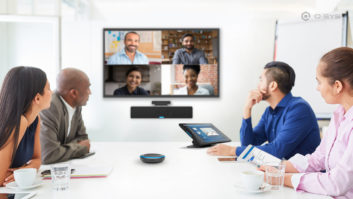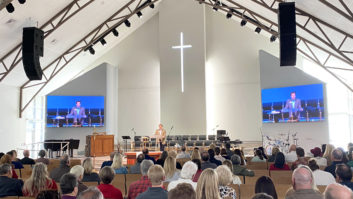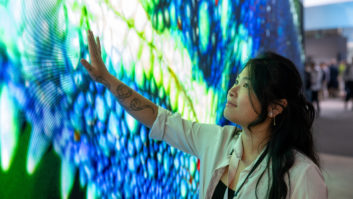With large multipurpose stadiums and boisterous crowds, high quality, flexible and diverse audio capabilities are essential for both entertainment and crowd safety
Marc Kocks, Powersoft’s business development manager, fixed install, offers AVTE readers his expert advice on things to consider…
1. Safety and crowd management are crucial to make sure your system is protected and works, always !
A large and passionate crowd is the objective for every venue. Crowd management and safety need to work together to ensure this goal. While the public address (PA) system will ensure the entertainment side of things (music, animations, etc.), the compulsory voice alarm (VA) system will address the crowd in emergencies: the latter should be able to give clear instructions at a sound pressure level above the noise generated by supporters and large crowds. In stadia environments, many audio setups combine both the PA and VA systems. Within this “PAVA” configuration, audio quality is combined with extensive monitoring and control. Make sure your audio system (speakers and amps) are fit for mission-critical environments where entertainment but most importantly lives are at stake.
2. Large-scale sport venues are not only focussed on sports – make sure your audio system isn’t either
More often than not, stadia are also used for other functions like live concerts and other events. The systems have to be able to handle spoken word, music playback and even commercials. When designing or refurbishing your audio system, make sure it offers both flexibility and scalability. DSP and Dante enabled products will allow you to change the function and behaviour of the system with the click of a mouse. At the same time, make sure your amplifier has powerful limiters and crossovers to keep your system protected.
3. Think green
Efficiency/power consumption is one of the most important system design considerations in any stadium and can have a significant impact on your electricity bill, but also on your brand perception (spectators) and future business opportunities (partners, sponsors, and investors). Amplifiers play a pivotal role in achieving better efficiency. Dedicated fixed install products are a must to help facilitate a system design that is powerful, flexible and efficient. Class-D amplifier technology allows for a very dense power pack of amplifiers, which in turn saves a lot of rack space.
The key to power efficiency in an amplifier is a very low current draw and thermal dissipation. For example, we were recently involved in a power amplification upgrade at Dortmund’s Signal Iduna Park Stadium in Germany. After completing the installation, the owner recorded that the mains power required was limited by almost 40 per cent compared to the original solution. By changing them, the system integrator had full remote control and full remote monitoring available on the system as well.
Another example is the Lord’s Cricket ground whose audio network requires two to three hundred amplifier channels. By upgrading its amplifier system, Lord’s not only expanded its audio network dramatically but at the same time reduced its audio power consumption by 90 per cent.
4. Quantity doesn’t have to mean quality
Having more speakers and more amplifiers doesn’t mean your audio system will sound better. Ease of integration and power capabilities of your audio system can result in huge savings in both installation costs and operational costs, while still retain the highest possible audio quality. This can be illustrated by the Parc Olympique Lyonnais, now known as Groupama Stadium (Lyon, France), which was commissioned and delivered in 2017. This state of the art stadium comprises a very dense package of amplifiers (just 18 Ottocanali units) which is used to power 144 independent, configurable loudspeakers.
5. Always consider the end user
The ability to work with lots of different loudspeaker systems while still being able to use one amplifier platform is an important factor. The extensive monitoring, like Live Impedance monitoring, and redundant system set up offered on DSP enabled amplifiers allows for full integration in a PAVA system. A good graphical user interface will also save costs in setting up an audio system. Finally, an extensive third-party control will also help to integrate with various kind of systems like fire detection systems or maybe another DSP system.
6. IT is your friend
The growing presence of IT networks in sporting venues simplifies the use and operation of any audio system. Make sure your amplifier offers a powerful DSP platform to ensure full user integration while guaranteeing the best audio quality. Digital audio networks like Dante also allow for full integration of the audio system into the venues IT system.
7. Choose the right provider
There is no such thing as a “one size fits all” amplifier. Every single stadium and sports venue will have different requirements. Integrators and specifiers will play a critical role in helping you chose the right product for your venue, so it is important that you chose people you can trust to provide the right solution for your specific needs. As far as amplifiers are concerned, a good indicator is the depth of the proposed install line of products, which should have specific models that are able to cover a full range of applications, while using the same DSP platform and means of digital audio transport (Dante) so the models can be mixed and matched to perfectly suit power requirements.
Audio quality is very important. The way Class-D amplification and DSP management are used is very useful to achieve pristine audio experience.
8. Choose the right software
A user friendly, remotely controllable software is as important as the quality of your hardware. A good software will allow users and the system integrators alike to create presets for the system and allows for good signal processing. The more functionality, the easier it will be to control and monitor your system. A good software will also need to be intuitive while allowing to create different presets and user interfaces that will match the level of knowledge from the operators. Last but not least, a good software should be open to all kinds of systems, so it can seamlessly work with third party-controlled systems. For example, if you had a Creston system or maybe another DSP system, you want to make sure you will still be able to use it with the software’s user interface.
9. Don’t fear change
Looking ahead, I think that one of the most important aspects of stadium installation in the next few years will be the ability to integrate products or the systems in to the venue’s existing Ethernet structure. In other words – a product’s ability to sit on an Ethernet structure and be used in the stadium’s general Ethernet backbone.
Another forthcoming trend is decentralised DSP, wherein the DSP is essentially split across the amplifiers, so they are better equipped to protect the loudspeakers and monitor the system. By using a decentralised DSP solution, we are also limiting the amount of network traffic and reducing the channel count of on the network.







